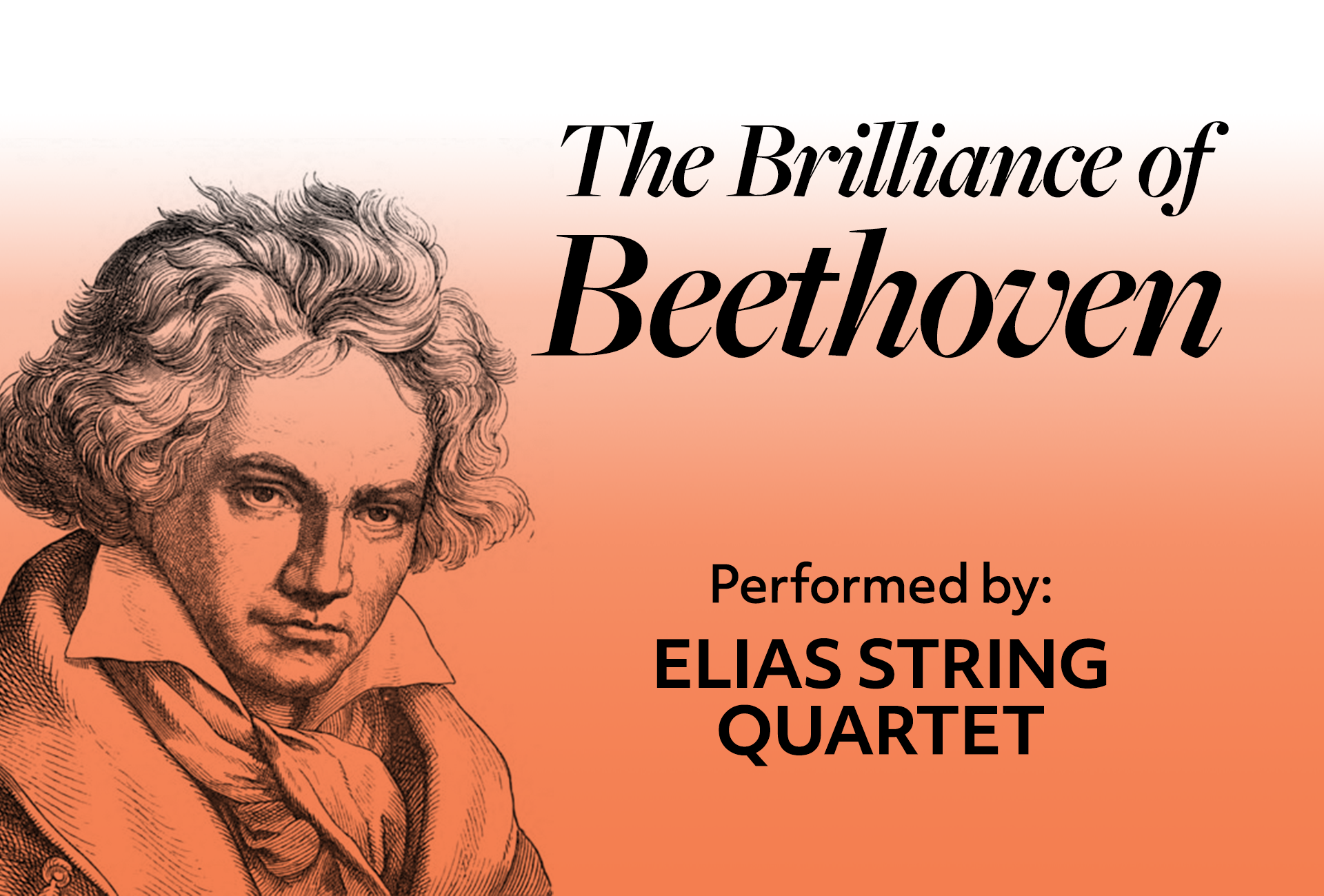Blog Post
Experience the Brilliance of Beethoven: Elias String Quartet Presents "The Beethoven Project"
The Gallagher Bluedorn, with support of Martha Kroese and other sponsors, will undertake a once in a lifetime musical adventure beginning this spring. Ludwig van Beethoven is one of the most admired composers in the history of Western music, with works spanning the Classical and Romantic period of Western music. His legacy of works are some of the most played and most recognizable in the classical tradition.
Over the span of his life, Beethoven composed sixteen great string quartets. The Elias String Quartet, a striking European quartet, created “The Beethoven Project” to showcase the late composer’s genius and now the Cedar Valley has the distinct opportunity to experience this thrilling exploration. Over the span of six concerts, all sixteen Beethoven quartets will be performed in an order selected by the quartet to compare and contrast the composer’s brilliance of his early, middle and late creative periods.
Experiencing the mind and creativity of a bona fide genius is certainly a rare opportunity and we are delighted to invite you to join us to hear some of the world’s greatest music over the span of six concerts.
Here is the spring schedule with a few notes:
Tuesday, March 22, 2022
String Quartet in A major, Op. 18, No. 5 (1798-99) Influenced by Mozart’s K. 464 “ The Drum,” this piece pays homage (especially in the opening movement) to the earlier composer’s work and then takes us in new and delightful directions. This work offers echoes of Mozart and then takes a turn toward the emotional content of Beethoven’s later works.
String Quartet in C major, Op. 59, No. 3 (1806) The third and final of the Rasumovsky quartets. While listening to this piece, I was struck by the balance of intellectual, almost arithmetic thoroughness of the investigation of the C minor chord in the opening movement, its transition to the more soothing and counterpoint-rich third movement, and finally the glorious and effulgent final movement. That last movement’s energy and joy is what makes this quartet unique in the cycle.
String Quartet in C sharp minor, Op. 131 (1826) Beethoven’s final and, dare I say, greatest quartet. Played without pause the quartet starts with a contemplative adagio that was described by Wagner as “the saddest thing ever said with notes.” In a fierce finale, the quartet explodes. “This is the fury of the world’s dance - fierce pleasure, agony, ecstasy of love, joy, anger, passion and suffering; lightning flashes and thunder rolls; and above the tumult the indomitable fiddler whirls us on to the abyss” wrote Wagner.
Thursday, March 24, 2022
String Quartet in G major, Op. 18, No. 2 (1798-99) To some, Beethoven’s early quartets would be easy to dismiss. However, even in his earliest compositions, Beethoven wrote with the style and influences of Hadyn and Mozart at their peak. Because of these obvious influences, this quartet earned the nickname “Compliments quartet” for its genial and pleasing tonality and the literal depiction of a conversation suggested by the question and answer quality of the first movement.
String Quartet in F minor, Op. 95 (1810) The last of Beethoven middle quartets, “Serioso” sets the stage for the late quartets, the first of which would be written 14 years later. Powerfully intellectual, filled with frantic crescendos and contrasting softness, “Serioso” is Beethoven’s shortest quartet and is distinct from the rest of his work. After its release, Beethoven wrote to an admirer saying “the quartet is written for a small circle of connoisseurs and is never to be performed in public.”
String Quartet in B flat major, Op. 130 (1825-26) The third of his late quartets, Beethoven wrote this quartet almost one year after completing his 9th Symphony. The fourth movement, in the form of a German dance, allows the listener to catch their breath but is swiftly followed by a deeply emotional, anguished Cavatina. The Grosse Fugue that ends the piece is remarkable in its energy and dramatic investigation of repetition and theme.
Friday, March 25, 2022
String Quartet in F major, Op. 18, No.1 (1798-99) In his early quartets, the lineage and structures developed first by Hadyn and then adopted by Mozart are at the forefront. It is easy to hear these influences in this work but a careful ear will hear traces of the innovation to the form that is to come from the great Beethoven. In this piece, the contrast of the bright and airy first movement with the darkness and pathos of the second movement (inspired by the tomb scene from Romeo and Juliet) provides an early glimpse of his later work almost 20 years later.
String Quartet in D major, Op. 18, No. 3 (1798-99) Believed by many (despite the numbering) to be the first quartet completed by Beethoven. Most notable in this work is the composer's ebullient sense of humor. Full of unexpected twists and turns, unexpected harmonies and grand musical phrases that, like the last movement, ends in a whisper.
String Quartet in A minor, Op. 132 (1825) One of his late works, this quartet was written after Beethoven had just recovered from a health crisis and was struggling with his worsening hearing loss. Despite this, nearly half of the quartet is made up of a single movement entitled “Holy Song of Thanksgiving from a Convalescent to the Divinity, in the Lydian mode.” After the tone of this grand movement fades, Beethoven brings us back to the world with a perky little march which soon gives way to the final movement replete with the changes of tempo and passionate, quasi-vocal recitative reminiscent of an opera.
And there. I’ve given it away. The more astute mathematicians amongst you will have noticed that there will need to be three more concerts if we are to experience the entire sixteen quartets. We will be announcing the specifics of those concerts over the summer but we invite all classical enthusiasts to embark with us on this first stretch of the journey this March.
The Beethoven project is remarkable but it is also demanding. To have the full experience will require you to join us for six nights over the course of one year. We hope you will join us for this classical rollercoaster ride.
To learn more about the Elias String Quartet, visit eliasstringquartet.com
To learn more about “The Beethoven Project,” visit thebeethovenproject.com
To purchase tickets to the first leg of this unforgettable experience, visit GBPAC.com/Elias
Blog by Steve Carignan, Executive Director



